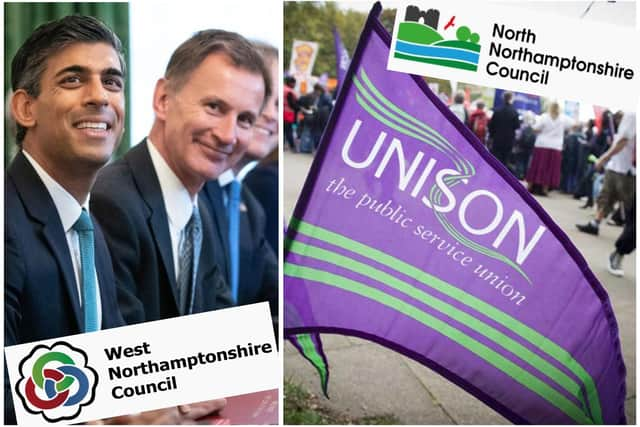Union warns of Northamptonshire councils’ £40m deficit next year as Bank of England hikes interest rate
and live on Freeview channel 276
Councils in Northamptonshire could be forced to cut essential services after confirming they face a collective funding gap of more than £40 million in the next financial year.
A report by public service sector union UNISON warns waste collections, leisure centres, nurseries and other vital services will all be hit according to the information from the two local authorities’ medium-term financial strategy.
Advertisement
Hide AdAdvertisement
Hide AdIt shows North Northamptonshire Council is set to be the second worst affected council in the region with a £25.1 million deficit — only Leicester City Council is higher with a funding gap of £48.3 million. And West Northamptonshire, which is already predicting a £7.6 million shortfall for this year, says it is likely to face a £15.5 million deficit when it sits down to decide its budget for 2022-23.


The report comes as the Bank of England hiked interest rates to three percent and UNISON says the picture is likely to get bleaker in the two Tory-run councils with Chancellor Jeremy Hunt set to announce further cuts to the public sector in his Autumn Budget on November 17.
The union’s East Midlands head of local government Rachel Hodson added: “Local authorities provide the essential services everyone relies on such as waste collection, road repairs, and children’s care. But cash-strapped councils are having to resort to ever more desperate measures after years of austerity just to keep services going. Now the Government looks set to make their predicament infinitely worse with emergency cuts to spending following the mini-budget fiasco.
“UNISON East Midlands has written to all the region’s Conservative MPs to ask them to sort the crisis in local Government funding and give councils the cash they need to save services.”
Advertisement
Hide AdAdvertisement
Hide AdThe record shortfall, totalling £181 million across 40 councils in the East Midlands in 2023-24 means local authorities will be forced to rely on dwindling reserves and cut services and jobs, says UNISON.
UNISON says skyrocketing inflation, energy costs and the economic impact of the Kwasi Kwarteng’s mini-budget means the actual shortfalls will be many times higher. And as the cost-of-living crisis deepens and inflation soars, even greater strain will be placed on councils as their costs increase and demand grows for food banks and other support. The union’s research, based on data relating to 40 local councils across the region, found that all but four — Chesterfield, Harborough, High Peak and North East Derbyshire — have predicted budget gaps.
West Northamptonshire councillors are due to hear on Thursday (November 3) about the authority’s latest financial position.
A report from finance cabinet member Malcolm Longley says: “Since the last report was published in September there have been further updates received on the financial position and it is pleasing to report that the forecast variance has reduced since the report was published.”
Advertisement
Hide AdAdvertisement
Hide AdThat report was prepared well before the recent financial turmoil and includes a forecast that interest rates could reach 2.75 percent by March 2023.
The Bank of England announced on Thursday (November 3) it is raising the cost of borrowing to three percent from 2.25 percent — the biggest jump since 1989.

